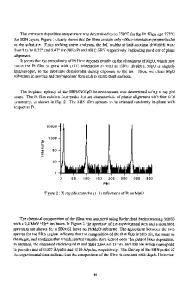Preparation and microstructure of SrCuO 2 /(Sr 0.5 Ca 0.5 )CuO 2 epitaxial multilayers with the infinite-layer structure
- PDF / 1,156,435 Bytes
- 6 Pages / 576 x 792 pts Page_size
- 96 Downloads / 238 Views
Multilayer thin films of SrCu02/(Sro.5Cao.5)Cu02 with an infinite-layer structure have been prepared on (100) SrTiO3 single crystals by multitarget rf magnetron sputtering. The structural analyses of the multilayers were carried out by means of x-ray diffraction (XRD), secondary ion-mass-spectroscopy (SIMS), and transmission electron microscopy (TEM). Heteroepitaxial growth of the SrCuO 2 and (Sr0.5Cao.5)Cu02 layers was confirmed to be with the c-axis perpendicular to the (100) SrTiO3 surface. The XRD and SIMS measurements revealed that the compositional modulations of the multilayer films were successfully constructed as we designed. However, in the TEM images, there existed planar dislocations parallel to the ac- and fcc-planes, which went across the boundaries of the SrCuO2 and (Sr0.5Cao.5)Cu02 layers. The resistivity of the multilayer films showed semiconductor-like behavior with temperature, and there was no relation between electric properties and modulation wavelength.
I. INTRODUCTION The "infinite-layer" structure, having an infinite stacking of CuO 2 planes and alkaline-earth elements, was first discovered by Siegrist et al.1 in (Ca0.86Sr0.i4)CuO2. This compound has the simplest crystal structure among the materials with two-dimensional copper-oxygen planes and has been considered to be a parent material of high-J c superconducting cuprates. Takano et al. expanded the composition range of the infinite layer compounds from (Sr1/3Ca2/3)CuO2 to (Ba 1/3 Sr 2 / 3 )Cu0 2 in high-pressure synthesis.2 Superconductivity was subsequently obtained in these compounds made under high pressure. (Sr, [Ba or Ca])CuO2 was found to be a holedoped superconductor (p type) with a critical temperature (Tc) of more than 100 K,3-4 and (Sr, Ln)CuO2 compounds (Ln = Nd, La, Pr, Sm, or Gd) were found to be electron-doped superconductors (n type) with a Tc about 40 K.5'6 The crystal structure of the n-type (Sr, Ln)CuO2 superconductors is an ideal infinite-layer structure, while that of the />-type (Sr, [Ba or Ca])CuO2 superconductors is undetermined and is considered to be an infmite-layer-related structure with a long-range modulation of some type along the c-axis.4-7 Thin-film processing has also been found to realize the infinite-layer ACuO 2 (A = CaSrBa). 8 " 11 Previously we reported superconducting thin films of H-type (Sr, Nd)CuO 2 made by sputtering.12 The laser ablation method has also been used to fabricate «-type films.13'14 One of the goals of our current research is to clarify the structure of the p-type infinite-layer superconductors. In particular, what is the nature of the modulation along the c-axis in the /?-type infinite-layer superconductors? J. Mater. Res., Vol. 9, No. 8, Aug 1994
http://journals.cambridge.org
Downloaded: 18 Mar 2015
To that end, we have been trying to introduce artificially the modulation along the c-axis by making multilayers of the infinite-layer materials SrCuO2 and (Sr0.5Ca0.5)CuO2. The fabrication of such a multilayer structure is complicated by the fact that these materials are stable o
Data Loading...











